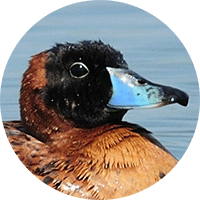Masked Duck
Appearance: It measures around 33 cm (13 in) in length and has a wingspan of about 64-74 cm (25-29 inches). Males and females exhibit sexual dimorphism, meaning they have distinct physical differences. The male has a striking appearance with a black head, neck, and upper body, which gives the species its name. Its bill is dark, while its eyes are yellowish. The upper wings are brownish-black, and the underparts are white. In flight, a white patch can be observed on its wings. The female has a more subdued appearance. She has two black facial stripes. It has a brownish mottled plumage with pale streaks on its underparts. She lacks the distinctive mask found in males but retains the white wing patch seen during flight.
Habitat: The masked duck is a resident bird found in various regions of the country. It typically inhabits wetlands, lagoons, marshes, and flooded areas. Its coloration and physical characteristics resemble those of the species as described globally, with the males displaying the prominent black mask on their heads and necks.
Geographic Variations: The masked duck's appearance may vary slightly depending on the region within Colombia. Birds in coastal areas, such as the Caribbean coast or the Orinoco River Basin, may have adaptations suited to those specific environments. Individuals residing in the Amazon rainforest or Andean regions may also exhibit slight variations in coloration or size based on local ecological factors.
Conservation: The masked duck is listed with a status of least concern.
Distribution
Northern Colombia:The masked duck can be found along the Caribbean coast of Colombia, including areas such as the Guajira Peninsula, Magdalena Department, and Atlántico Department. It occurs in wetlands, lagoons, and marshes in these coastal regions.
Orinoco River Basin:The masked duck is also distributed in parts of the Orinoco River Basin, which covers areas in eastern Colombia, including Vichada Department, Meta Department, Guainía Department, and Arauca Department. It inhabits freshwater wetlands and floodplains associated with this river system.
Amazon Rainforest: Within the Colombian Amazon rainforest, particularly in the southern part of the country, the masked duck can be found in regions such as Amazonas Department, Putumayo Department, and Caquetá Department. It occurs in oxbow lakes, riverine habitats, and flooded forest areas.
Eastern and Western Andes: The Masked Duck is also reported in certain locations within the Eastern and Western Andes mountain ranges in Colombia. These regions include Cundinamarca Department, Boyacá Department, and Nariño Department. It can be found in highland lagoons, marshes, and wetland habitats associated with these mountainous areas.
Taxonomy
- Kingdom: Animalia
- Phylum: Chordata
- Class: Aves
- Order: Anseriformes
- Family: Anatidae
- Genus: Nomonyx
- Species: Nomonyx dominicus
Vocalization
The Masked Duck has a low-pitched, rather raspy vocalization that consists of a series of grunts, croaks, and quiets clucks. The vocal repertoire of the masked duck is relatively limited compared to some other duck species.
The vocalizations of the male and female Masked Ducks are quite similar. During courtship and breeding season, male masked ducks produce a distinctive courting call consisting of a repeated "quack-quack-quack" sound. This call is often described as a soft, low-pitched, and repetitive croak. This vocalization serves to attract females and establish dominance among males in their breeding territories.
In contrast, the female Masked Ducks emit rather soft clucks or grunts, often as contact calls to communicate with their young or other members of their group.
These quiet vocalizations help keep the group together while foraging or moving through their wetland habitats.
Breeding
Breeding Season: Masked ducks typically breed during the wet season or rainy months in their respective habitats. Breeding seasons can vary based on geographical location.
Pair Bonding: Masked ducks are known to form strong monogamous pair bonds that often last for multiple breeding seasons. Once a pair bond is formed, the male and female work together to raise their offspring.
Courtship Displays: During courtship the male masked duck engages in elaborate displays to attract a female. Courtship displays can include head bob, wing flapping neck stretching, and vocalizations. The male may also swim around the female in circular patterns to showcase his attractiveness.
Nesting: Masked ducks build nests on the ground, commonly hidden among vegetation or near water bodies. The nests are usually well-hidden and made of plant materials, such as grasses and leaves. The female mainly constructs the nest, and the male may assist by bringing materials.
Egg Laying and Incubation: The female masked duck typically lays a clutch of about 6-10 eggs, which she incubates for approximately 24-26 days. During the incubation period, the female remains dedicated to the nest while the male stands guard nearby, protecting the territory.
Parental Care: Once the eggs hatch, both the male and female actively care for the ducklings. They guide the young to suitable feeding areas and provide protection from predators. Masked ducks are known to display cooperative brooding, where multiple females may tend to a single brood of ducklings.
Fledging: The ducklings fledge around 50-60 days old, gaining their flight feathers and becoming capable of sustained flight. After this stage, the young masked ducks become independent from their parents. The masked ducks inhabit wetland habitats, and their breeding behavior can be influenced by various environmental factors, including water availability and food abundance.





